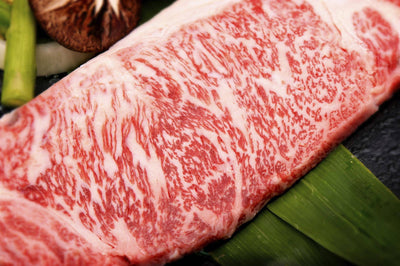Marbling 101: Be a Marbling Grade Expert

Marbling is the intramuscular fat within muscles in beef and lamb.
Why are there so many different marbling grades though and what do they mean? What is the "best marbling grade"? Here we answer some of these questions related to the meat we have in our meat shop, La Carne, which mostly originate from Australia, but also Japan and the USA.
THE US MARBLING GRADE SYSTEM

There are various categories of grading meat in the US system, the most popular of which is Choice, Select and Prime. Prime is the highest grade and also the most expensive whereas Select and Choice are also great quality but less marbling. The less popular are Utility, Cutter and Canner and those are used in meat processing. At La Carne, we offer only Certified Angus Beef brand from the US which are usually Prime Rib and Short Ribs (other cuts can be ordered for you as well).
The Certified Angus Beef brand

- Considered the highest marbling grade for US Beef, applied to all three categories (so you can have Certified Angus Beef Choice, Select or Prime).
- Independent USDA graders inspect black-hided cattle (typical of the Angus breed) and give it a grade. All beef considered for the brand must be the best Choice, or Prime, beef – truly the top of the scale. This top-quality Angus beef is then evaluated again, using the Certified Angus Beef brand's set of 10 science-based specifications for marbling, size and uniformity. If it's good enough to make the cut, then it earns the distinctive Certified Angus Beef ® brand label.
- All La Carne US beef cuts are Certified Angus Beef Cuts.
THE AUSTRALIAN MARBLING GRADE SYSTEM

Many favor Australian beef and lamb as they have, in our opinion, the best standards system in the world when it comes to meat.
In Australia, there are two official systems- AUSMEAT and Meat Standards Australia. They both produce comparably consistent marbling results.
Meat Standards Australia (MSA) was developed by the Australian red meat industry to improve the eating quality consistency of beef and sheepmeat. The system is based on almost 800,000 consumer taste tests by more than 114,000 consumers from 11 countries and takes into account all factors that affect eating quality from the paddock to the plate. Wow!
So how do Aussie Marbling Grades work?
Quite simply, Australian Marbling grades range from 1 to 9. Meat with little or no marbling suggests the cattle was mainly grass-fed whereas meat with much marbling is considered from cattle fed with more grain.
How to know the Australian Marbling Grade?
Simply ask your butcher what is the marbling and it will most likely be displayed on the meat packaging as MB and the number of the grade.
THE JAPANESE MARBLING GRADE SYSTEM

Wagyu literally translates to Japanese Cow or Beef. Therefore all the cattle in Japan are Wagyu and are of extremely high quality due to the restrictions placed on crossbreeding and conservation of cattle genes.
Consider the chart below:

In this chart you can see a yield grade which means how much meat is collected from a carcass. C is smallest while A is the biggest. Quality Grade has to do with the actual marbling. Therefore A5 is the highest marbling score when it comes to Genuine Wagyu beef from Japan.
Now check out this chart:

Above you can see that the Japanese chart is the biggest with the most marbling levels. In Japan marbling levels 8 to 12 are all considered A5, the highest possible grading.
How to know the Japanese Marbling Grade?
Each Japanese Wagyu carcass comes with a grading table, pedigree chart and halal certificate. The grading table will show the exact marbling level and grade of the meat.
SO WHAT'S THE DIFFERENCE BETWEEN AUSTRALIAN WAGYU OR JAPANESE WAGYU?
Australian and Japanese Wagyu marbling cannot be compared. It's like wine or cheese from different regions!
It is extremely difficult to compare Australian and Japanese wagyu directly due to the many different ways wagyu can be produced. Every farmer has different methods and production processes. It would be much easier to compare farmers rather than an entire countries’ methods.
Australia’s soils, climate, grasses and rainfall are all different to Japan which will affect the taste, texture and quality; all beef should be celebrated for these differences.
In Australia, it is recommended that the grading is completed between the 10th and 11th rib; in Japan, it is between the 6th and 7th rib.
So what marbling is best?
According to our contacts from Kobe, Japan, for them the best marbling for Wagyu originating from Japan is 8 because you still have a good balance of meat and beautiful fat marbling.

I personally love an Australian Wagyu Ribeye of Marbling 1-2 on weekdays and on special occasions a higher marbling of 6-7 (shown above) when I would like a more melt-in-the-mouth experience.

Japanese beef if I were to have it would be fantastic at the A5 grade (usually we offer 8-9 marbling to our customers) sliced shabu shabu (hotpot) or yakiniku (BBQ) style (above).
But meat is a personal experience and preference. You have to keep trying until you've found the one!
Thanks for reading, let us know your thoughts below!
Meaty regards,
Joan
Group Brand Manager at La Carne
Written April 2018, revised Dec 2021
Sources:
https://www.mla.com.au/marketing-beef-and-lamb/meat-standards-australia/
https://meat.tamu.edu/beefgrading/
https://www.certifiedangusbeef.com/cuts/grades.aspx
https://www.usda.gov/media/blog/2013/01/28/whats-your-beef-prime-choice-or-select
https://guide.michelin.com/sg/dining-in/ask-the-expert-the-difference-between-japanese-and-australian-wagyu/news


















Leave a comment